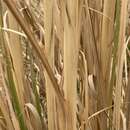pms
nòm ant ël fil


Saccharum bengalense (lat. Saccharum bengalense) - qırtıckimilər fəsiləsinin şəkərqamışı cinsinə aid bitki növü.
Saccharum bengalense (lat. Saccharum bengalense) - qırtıckimilər fəsiləsinin şəkərqamışı cinsinə aid bitki növü.
Saccharum munja (lat. Saccharum munja) - qırtıckimilər fəsiləsinin şəkərqamışı cinsinə aid bitki növü.
Saccharum munja (lat. Saccharum munja) - qırtıckimilər fəsiləsinin şəkərqamışı cinsinə aid bitki növü.
Tripidium bengalense, synonym Saccharum bengalense,[1] with the common names munj sweetcane,[2] baruwa sugarcane or baruwa grass, is a plant of the genus Tripidium native to Iran, Afghanistan, Pakistan, Northern India, Nepal, Bangladesh and Myanmar.[1][3]
A primary native distribution area is northeastern India, particularly in Assam within the Terai-Duar grasslands in the foothills of the Himalayas.
This is a small species of sugarcane bamboo grass, growing 2–3 feet (0.61–0.91 m) in height. The plant is colored pinkish-green.
It is a food source for animals such as the Indian rhinoceros and the pygmy hog.
The species is used as a raw material for thatching roofs. It is used for making baskets. Its fibre is used for making ropes. Itis one of the ecologically successful native colonizer of abandoned mines. It forms pure patches on rocky habitats with skeletal soils. It forms extensive root network that binds the soil/pebbles and forms tall thick clumps with high biomass tufts. It is used by low income locals for making ropes, hand fans, baskets, brooms, mat, hut and shields for crop protection. It is a choice species for stabilizing erosion-prone rugged slopes and their conversion into biologically productive sites of high socio-economic values.[4]
Tripidium bengalense, synonym Saccharum bengalense, with the common names munj sweetcane, baruwa sugarcane or baruwa grass, is a plant of the genus Tripidium native to Iran, Afghanistan, Pakistan, Northern India, Nepal, Bangladesh and Myanmar.
A primary native distribution area is northeastern India, particularly in Assam within the Terai-Duar grasslands in the foothills of the Himalayas.
Saccharum bengalense, alternativamente Saccharum bengalensis, con los nombres comunes de caña dulce, caña de baruwa o hierba de baruwa, es una planta del género Saccharum nativa del norte de la India, Afganistán, Pakistán e Irán.[1]
Su área de distribución nativa primaria es India del noreste, particularmente en Assam dentro de las praderas de Terai-Duar en las estribaciones del Himalaya.
Es una especie de bambú pequeño de tallo dulce, que crece de 60 a 90 cm de altura. La planta es de color rosa verdoso.
Es una fuente de alimento para animales como el rinoceronte indio y el jabalí enano.
Saccharum bengalense, alternativamente Saccharum bengalensis, con los nombres comunes de caña dulce, caña de baruwa o hierba de baruwa, es una planta del género Saccharum nativa del norte de la India, Afganistán, Pakistán e Irán.
Su área de distribución nativa primaria es India del noreste, particularmente en Assam dentro de las praderas de Terai-Duar en las estribaciones del Himalaya.
Saccharum bengalense là một loài thực vật có hoa trong họ Hòa thảo. Loài này được Retz. miêu tả khoa học đầu tiên năm 1789.[1]
Saccharum bengalense là một loài thực vật có hoa trong họ Hòa thảo. Loài này được Retz. miêu tả khoa học đầu tiên năm 1789.